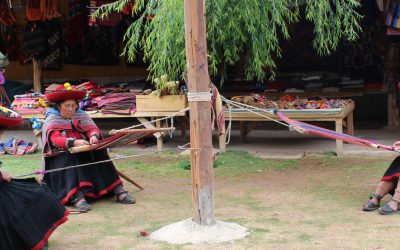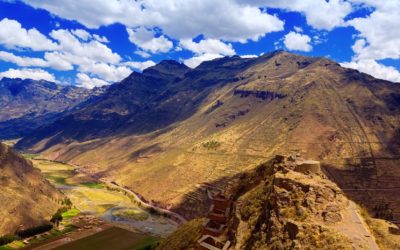The Sacred Valley
Travel Guide
Introduction to The Sacred Valley
The agreeable climate and fertile plains of the Sacred Valley are a rare and fruitful combination for the high Andes. These lush agricultural lands that once nourished the Inca Empire continue to this day to supply nearby towns and cities such as Cusco, with much of their natural produce.
Many travelers traveling to Peru do not stop to take their time to immerse themselves in the beauty of the Sacred Valley as they pass by or through it to visit the main highlight of Machu Picchu. However, spending time to explore the small Inca towns and impressive archaeological sites of the Sacred Valley will give you a unique insight into both the modern day and historical life in Peru. Highlights of the region include the markets and the lofty Inca archaeological sites of Pisac, Ollantaytambo and Chinchero as well as the Maras salt pans and the agricultural terraces of Moray.
This beautiful part of Peru is also one of the best areas for a wide range of adventure activities including trekking, horseback riding, whitewater rafting and mountain biking among many others. The Sacred Valley is also filled with century old and brightly colored festivals, celebrations and indigenous practices that makes it a highlight of Peru that is waiting to be explored even further.
What not to miss in the Sacred Valley
Pisac
Pisac is a picturesque town situated at the entrance to the Sacred Valley and is home to a number of interesting highlights. The town’s arts and crafts market offer textiles and ceramic goods, plates, jewellery and replicas of pre-Hispanic pottery. There is also the Pisac archaeological complex nearby.
Maras Moray
Agricultural circles and Salt Flats – Moray is an amazing example of Inca ingenuity with terraces that vary in temperature to allow for the growing of different crops. The nearby pink Inca salt pans at Maras are also definitely worth a visit.
Ollantaytambo
The present town of Ollantaytambo has been built on top of the original Inca foundations and is considered the best surviving example of Inca urban planning. The older part of the town is still divided into blocks called canchas and remains almost entirely intact.
Visit a Weaving Community
Visit a weaving community for a unique opportunity to meet the local weavers, learn about their traditions, way of life and, support their craft knowing that 100% of the profit is going directly back to the person who wove the object you buy.
Chincheros
The Inca regard Chincheros as the birthplace of the rainbow and, this typical Andean village brings together Inca ruins with a colonial church, some breathtaking scenery and a colorful, local market.
Mountain Bike
If you’re looking for a bit of adventure in the Sacred Valley then look no further than going mountain biking through this impressive valley. Surrounded by the Sacred Valley’s stunning mountain scenery you’ll ride through traditional Andean towns and visit Inca ruins.
Rafting
Take a break from exploring Inca ruins and enjoy a thrilling rafting adventure in the Sacred Valley. As you make your way down the adrenaline-pumping Class II, III and IV rapids on the Urubamba River there are also a few calmer sections where you can soak up the beauty of the Sacred Valley.
Inca Jungle trek – 3 days
This 3-day trek to Machu Picchu combines thrilling adventures, extreme sports and unbelievable trekking for an action packed experience as you make your way to Machu Picchu. From mountain biking and zip-lining to, sleeping deep in the jungle and trekking along lost Inca trails; this adventure to the World Wonder of Machu Picchu has it all!
Lares Trek – 3 days
The 3-day Lares Trek to Machu Picchu takes you to remote, authentic villages and off the beaten path where you’ll have more interactions with the local Peruvian culture and people instead of numerous ancient Inca ruins.
Salcantay Trail – 5 days
The Salkantay Trail (Salcantay Trail) is regarded as the ‘Alternative Inca Trail.’ Offering scenery and diversity just as spectacular as on the Inca Trail, the Salcantay Trail goes one step further with the 20,500 ft. high Mount Salcantay, one of the holiest Inca apus (sacred peaks).
What you need to know

When to go
The Sacred Valley can be visited all year round; however the best time is between May and October. Its altitude gives it sun during the day and cold temperatures at night. Rainy season is between November and March. The driest time of the year is between June and August, but this is also peak tourist season as it coincides with summer holidays in the northern hemisphere.

How to get there
Cusco is the nearest airport to the Sacred Valley and there are flights to the airport from Lima, Puno, Arequipa, Puerto Maldonado, and La Paz (although flights from Bolivia only run twice a week). There are over 15 flights from Lima to Cusco a day. Flights are safe although one should be cautious of the sudden altitude change which can bring about brief periods of altitude sickness.
Travelers can reach the Sacred Valley by frequent buses that run from Cusco. Alternatively, you can get a taxi from Cusco or organize a transfer (shared or private) to your accommodation in the Sacred Valley.
Where to stay
There are a number of fabulous accommodations options available in the Sacred Valley. Surrounded by the lush landscapes of this region, starting your visit to the Peruvian Andes in the Sacred Valley has a number of advantages over beginning your stay in Cusco. Staying in the Sacred Valley which is at a lower altitude to Cusco will give you time to acclimatize to the high altitude and lessen the chance of altitude sickness. As the Sacred Valley is near to Cusco, you’re never too far away from the Cusco’s lively atmosphere.
Getting around
Paved roads and plenty of transport make the Sacred Valley a relatively straightforward place to explore. You can also explore the Sacred Valley on foot, by bike or on horseback.

Search our blog for great tips and destination information
or check out a few of our favorites!
Visiting Peru’s Andean Weaving Communities
A Unique Experience at the Chincheros Weaving Cooperative One of the most unique and engaging experiences in Peru is visiting the Chincheros Weaving Cooperative. Surrounded by the stunning views of the Sacred Valley and its snow-capped peaks, the small village of...
Discovering the Sacred Valley in Peru
From the cobbled streets of the capital of the Inca Empire at Cusco to the majestic and magical heights of the Machu Picchu citadel; the Sacred Valley in Peru is a must-visit destination this summer! The fertile lands that nourished the Inca Empire flow through this...
Video | Diversity of the Sacred Valley | Horseback Riding to Paragliding
Officially known as the Urubamba Valley, the Sacred Valley of the Incas lies in the Peruvian Andes, about 10 miles north of the former Inca capital of Cusco. The historic gateway to Machu Picchu, the Sacred Valley draws many thousands of visitors each year, although...




